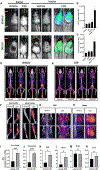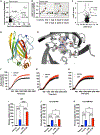Insulin sensitization by small molecules enhancing GLUT4 translocation
- PMID: 37453421
- PMCID: PMC11191318
- DOI: 10.1016/j.chembiol.2023.06.012
Insulin sensitization by small molecules enhancing GLUT4 translocation
Abstract
Insulin resistance (IR) is the root cause of type II diabetes, yet no safe treatment is available to address it. Using a high throughput compatible assay that measures real-time translocation of the glucose transporter glucose transporter 4 (GLUT4), we identified small molecules that potentiate insulin action. In vivo, these insulin sensitizers improve insulin-stimulated GLUT4 translocation, glucose tolerance, and glucose uptake in a model of IR. Using proteomic and CRISPR-based approaches, we identified the targets of those compounds as Unc119 proteins and solved the structure of Unc119 bound to the insulin sensitizer. This study identifies compounds that have the potential to be developed into diabetes treatment and establishes Unc119 proteins as targets for improving insulin sensitivity.
Keywords: GLUT4; Unc119; Unc119b; glucose uptake; high throughput screening; insulin resistance; translocation.
Copyright © 2023 Elsevier Ltd. All rights reserved.
Conflict of interest statement
Declaration of interests J.A.S., T.C.Y., and R.J.K. are inventors on a patent related to this work.
Figures




References
Publication types
MeSH terms
Substances
Grants and funding
LinkOut - more resources
Full Text Sources
Medical
Molecular Biology Databases

